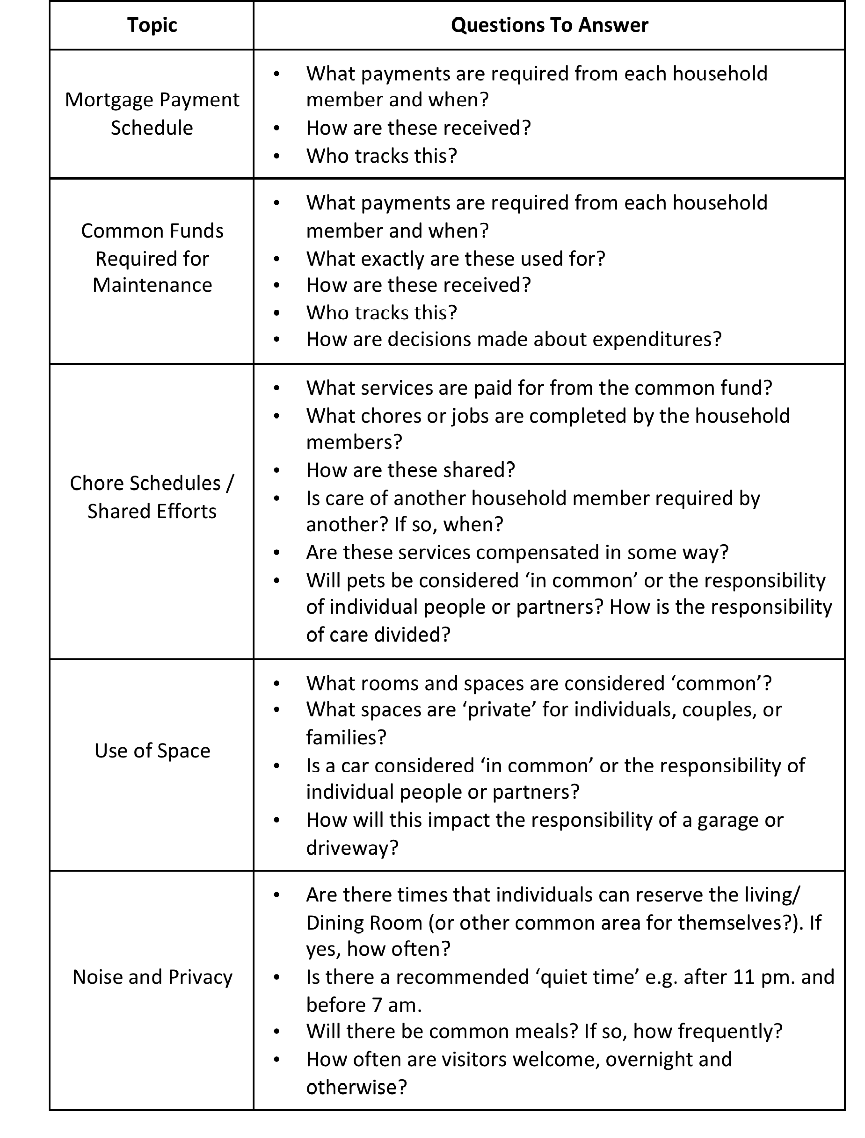By now, you and your group have assessed and discussed in great detail everyone’s financial history and current status. You should have written up a group budget and have an in-depth understanding of your financial model. It’s time to talk about house rules. Living in a group means compromising with others as well as co-ownership’s other pillars of compassion and co-operation. It is important to establish your house rules now before you purchase a home.
This is Part 3 in our series where we break down the co-ownership process into 5 key steps that every group of partners have to go through in order to cooperatively purchase their home. In Step 1, we discussed how to pick your perfect partners and Step 2 we went through the process of Building Your Financial Model. In this article, we will go through Step 3: Your House Rules.
Getting Started
At this point in the process, you’ve got to know your group and you should have an idea about how you want to live together. However, it is important to discuss rules and conduct with your group members. GOCO advocates for creating your group’s House Rules. Having an open table discussion and going through the finer details of your living arrangements is beneficial and prevents conflicts from happening in the future. An ounce of prevention is worth a pound of cure. It’s best to discuss as many potential challenges prior to purchasing a house. House Rules should cover everything from the contributions of group members and space management to maintenance responsibilities and communication. It can be as detailed as you want and GOCO always recommends more rather than less.
Another popular option is to create a Home Charter. Your Home Charter is a philosophy or overarching idea of how your group lives together, sort of like a ‘Mission Statement’. It can help you and your group align and share a common view of your home from the start. A Home Charter is unique to your group but below are a few examples.
“Our home is dedicated to supporting each other as we age in place. We respect each other’s independence as well as each other’s need for assistance from time to time. Above all, we take care of our home for each other and ourselves.”
“Our home is created so that 3 generations can live together. We will create a home so that we can support and learn from each other and meet the needs of all who live here.”
“Our home is created so that two families can live together in the most sustainable ways we can. We will reduce, reuse and recycle as much as possible and support each other to live in harmony with each other and the planet.”
A Home Charter allows your group to focus and align yourselves around the ideals that you want to embody in your home. It gives direction to shaping your house rules.
What Should I Put In The House Rules?
The House Rules of your group will depend on different factors and how you want to live together. In Step 1, we discussed the level of sharing in a co-operative household. You may remember this table below.
It is important that everyone agrees on the shared spaces. This will also influence how often the house meets. As well as house meetings, this table will also influence who’s responsible for what in the house. It is important to work through the responsibilities of each group member. For example, if food and meals are separate rather than shared, there’s less to discuss and establish. If they are shared, there needs to be discussion around the frequency of shopping, storage, dietary requirements and such.
Communication for the establishing your House Rules is crucial. Everyone in your group should put forward questions for the group to discuss and answer. Guided by how much shared space your group has and your House Charter, a discussion about what the House Rules need to address the following:
Of course, your group is unique and there may be more topics to address but GOCO recommends the above table to get started. The more questions and topics you address, the better prepared you are.
Let’s Talk About Decision-Making
Decision-making is an important aspect that needs to be addressed in the House Rules. There will be many decisions that need to be made amongst co-ownership partners. Perhaps renovations are going to be conducted? What about visitors or holidays? Some of these decisions may require a household vote. Your House Rules should outline the Decision Rights of each partner. GOCO also recommends that you include your Decision Rights in your legal agreement.
How your group awards decision rights will be dependent on the activities and requirements of the home. Many assume decision rights are mirrored by the equity shares of the household. However, equity is about the percentage of ownership of the property while decision rights influence what happens in the home. They don’t necessarily share the same distribution. Below is an example of three different households with different equity and decision rights.
In the case of evenly split decision rights, your group should have a procedure to deal with deadlock and tie-breakers. One co-ownership partner could have the ability to cast a tie-breaking vote. Or certain members have the ability to cast the tie-breaking vote depending on the decision category.
On The Matter Of Resolving Disputes
You should always know how your group is going to resolve any disputes or conflicts. As with any other arrangement and contract, you need to prepare for the possibility that things can go wrong. The methods for resolution can also be included in your legal agreement. GOCO recommends some ideas in the table below.
If we return to our example of the three households, we can see how they have compiled and devised their house rules based on their shared spaces and differing contributions as well as how often they set their house meetings.
Creating your Co-Ownership House Rules will require you all to sit down and discuss how you want your household to be run. By this point in the process, you should have gauged how everyone wants to live together and it is in this step that you all hammer out the finer details and put them on paper. Don’t be intimidated to put forward scenarios and bring up questions about visitors and conduct. Remember, discussing and creating rules in this step prevents conflict from occurring further in the future. GOCO is here to help you every step of the way and there are many resources available.
In the next step, we will discuss the process and importance of Creating Your Legal Agreement. Stay tuned!





